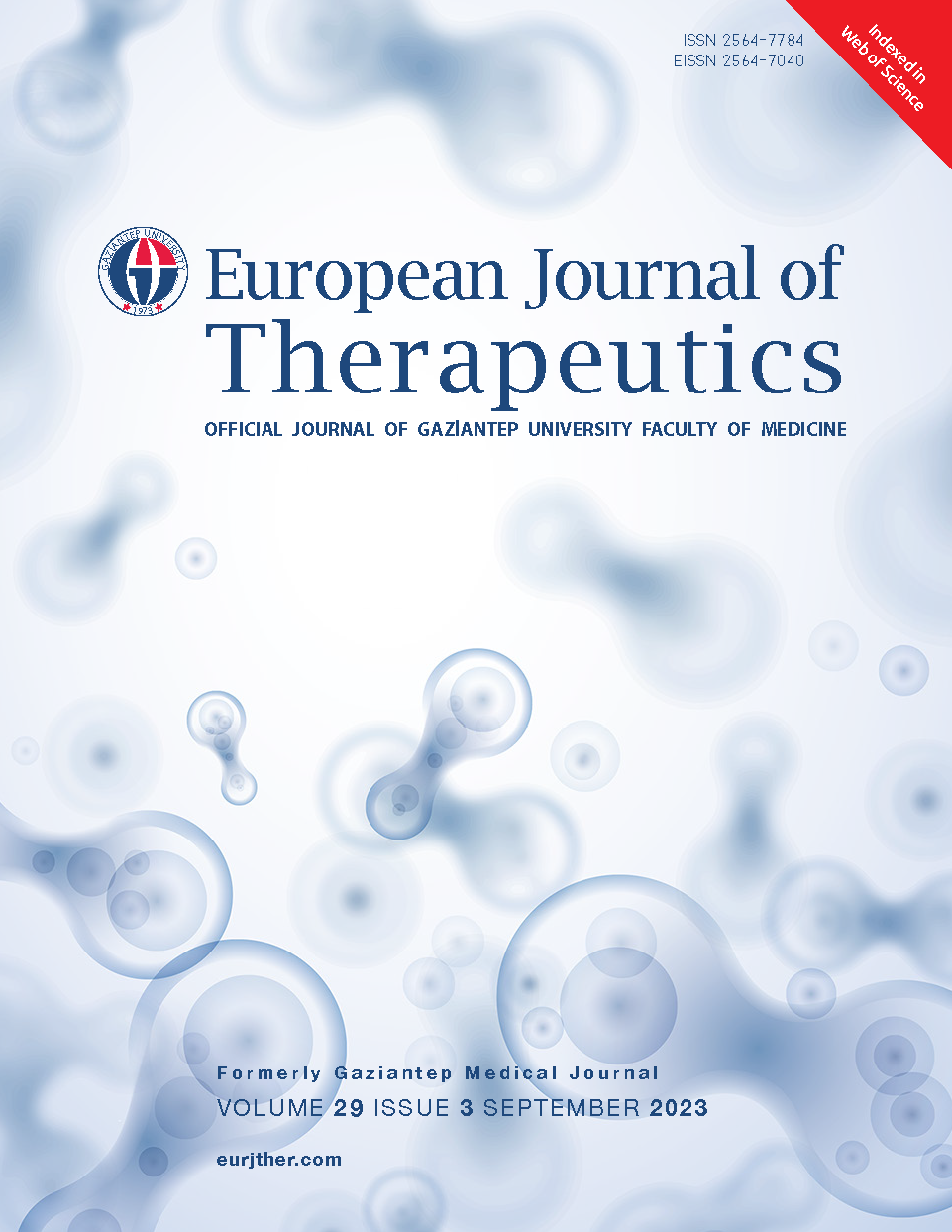The Effect of the Age at Seizure Onset on Seizure Resistance in Tuberosclerosis Patients
DOI:
https://doi.org/10.58600/eurjther1668Keywords:
tuberosclerosis, epilepsy, polytherapy, cortical tuberAbstract
Objective: To evaluate the clinical status of epilepsy, which is extremely widespread in tuberosclerosis patients and the findings and characteristics of a paediatric case series.
Methods: The study included paediatric patients diagnosed with tuberosclerosis from clinical or genetic examination who were followed up between 2015 and 2022 in the Paediatric Neurology and Paediatric Genetics Clinics of Necmettin Erbakan University Meram Medical Faculty Hospital. A retrospective examination was made of the clinical characteristics of the patients, the electroencepahalography (EEG) reports, and radiological findings (magnetic resonance imaging [MRI], ultrasonography, echocardiography). The patients were separated into two groups of monotherapy and polytherapy according to the number of drugs used, and the groups were compared in respect of the time of onset of epilepsy. The patients were also categorised according to the presence of cortical tuber and subependymal nodule and these groups were compared in respect of the presence of epilepsy.
Results: The 27 patients comprised 18 (66.6%) males and 9 (33.4%) females. Complaints on presentation were seizure and skin patches in 25 (92.5%) cases and only skin patches in 2 (7.5%). The most common finding determined on MRI was the combination of subependymal nodule and cortical tuber (51.8%). Autism spectrum disorder was present in 5 (18.5%) patients and mental retardation in 16 (59%). The age at onset of epilepsy was earlier in the polytherapy group [5±4.75 (1-18) months] than in the monotherapy group [8.0±16 (4-36) months] (p=0.032). The rates of presence of cortical tuber and subependymal nodule were similar in respect of the time of onset of epilepsy (p>0.05).
Conclusion: The early onset of epilepsy in tubersclerosis patients indicates that it may have a resistant course and there may be a need for polytherapy. There may also be accompanying neuropsychiatric retardation in these patients. The clinical status of epilepsy in tuberosclerosis was found to be similar in the cortical tuber and subependymal nodule groups.
Metrics
References
Raznahan A, Joinson C, O’Callaghan F, Osborne J, Bolton P (2006) Psychopathology in tuberous sclerosis: an overview and findings in a population‐based sample of adults with tuberous sclerosis. Journal of Intellectual Disability Research. 50(8):561-569. https://doi.org/10.1111/j.1365-2788.2006.00828.x
Cohen AL, Kroeck MR, Wall J, McManus P, Ovchinnikova A, Sahin M, et al. (2022) Tubers affecting the fusiform face area are associated with autism diagnosis. Annals of Neurology. https://doi.org/10.1002/ana.26551
Schwartz RA, Fernández G, Kotulska K, Jóźwiak S (2007)Tuberous sclerosis complex: advances in diagnosis, genetics, and management. Journal of the American Academy of Dermatology. 57(2):189-202. https://doi.org/10.1016/j.jaad.2007.05.004
Holmes GL, Stafstrom CE, Group TSS (2007) Tuberous sclerosis complex and epilepsy: recent developments and future challenges. Epilepsia. 48(4):617-630. https://doi.org/10.1111/j.1528-1167.2007.01035.x
Thiele EA. Managing epilepsy in tuberous sclerosis complex (2004) Journal of child neurology. 19(9):680-686. https://doi.org/10.1177/08830738040190090801
Westmoreland B. The electroencephalogram in tuberous sclerosis (1999) Tubrous Sclerosis Complex: Developmental Perspectives in Psychiatry, ed.3:63-74.
Curatolo P, Jóźwiak S, Nabbout R (2012) Management of epilepsy associated with tuberous sclerosis complex (TSC): clinical recommendations. european journal of pediatric neurology. 16(6):582-586. https://doi.org/10.1016/j.ejpn.2012.05.004
Northrup H, Krueger DA, Roberds S, Smith K, Sampson J, Korf B, et al. (2013) Tuberous sclerosis complex diagnostic criteria update: recommendations of the 2012 International Tuberous Sclerosis Complex Consensus Conference. Pediatric neurology. 49(4):243-254. https://doi.org/10.1016/j.pediatrneurol.2013.08.001
Kwan P, Arzimanoglou A, Berg AT, Brodie MJ, Allen Hauser W, Mathern G, et al. (2010) Definition of drug resistant epilepsy: consensus proposal by the ad hoc Task Force of the ILAE Commission on Therapeutic Strategies. Wiley Online Library. https://doi.org/10.1111/j.1528-1167.2009.02397.x
Fisher RS. The new classification of seizures by the International League Against Epilepsy (2017) Current neurology and neuroscience reports. 17(6):1-6. https://doi.org/10.1007/s11910-017-0758-6
Overwater I. Bindels-‐de Heus K, Rietman AB, Ten Hoopen LW, Vergouwe Y, Moll HA, et al. (2015) Epilepsy in children with tuberous sclerosis complex: Chance of remission and response to antiepileptic drugs. Epilepsia. 56(8):1239-1245. https://doi.org/10.1111/epi.13050
Jóźwiak S, Migone N, Ruggieri M (2008) The Tuberous Sclerosis Complex. Neurocutaneous Disorders Phakomatoses and Hamartoneoplastic Syndromes: Springer; p. 181-227. https://doi.org/10.1007/978-3-211-69500-5_5
Samir H, Ghaffar HA, Nasr M (2011) Seizures and intellectual outcome: clinico-radiological study of 30 Egyptian cases of tuberous sclerosis complex. european journal of pediatric neurology. 15(2):131-137. https://doi.org/10.1016/j.ejpn.2010.07.010
Józwiak S, Schwartz RA, Janniger CK, Bielicka-Cymerman J (2000) Usefulness of diagnostic criteria of tuberous sclerosis complex in pediatric patients. Journal of child neurology. 15(10):652-659. https://doi.org/10.1177/088307380001501003
Baron Y, Barkovich AJ (1999) MR imaging of tuberous sclerosis in neonates and young infants. American Journal of Neuroradiology. 20(5):907-916.
Saltık S, Karatoprak EY, Taşel B (2013) Characteristics and the clinical prognosis of epilepsy in patients with a diagnosis of tuberous sclerosis complex. Turk Arch Pediatr. 48:123-130. https://doi.org/10.4274/tpa.116
Park SM, Lee YJ, Son YJ, Kim YO, Woo YJ (2011) Clinical progress of epilepsy in children with tuberous sclerosis: prognostic factors for seizure outcome. Chonnam Medical Journal. 47(3):150-154. https://doi.org/10.4068/cmj.2011.47.3.150
Kassiri J, Snyder TJ, Bhargava R, Wheatley BM, Sinclair DB (2011) Cortical tubers, cognition, and epilepsy in tuberous sclerosis. Pediatric neurology. 44(5):328-332. https://doi.org/10.1016/j.pediatrneurol.2011.01.001
Wiznitzer M (2004) Autism and tuberous sclerosis. Journal of child neurology. 19(9):675-679. https://doi.org/10.1177/08830738040190090701
Kingswood JC, Bissler JJ, Budde K, Hulbert J, Guay-Woodford L, Sampson JR, et al. (2016) Review of the tuberous sclerosis renal guidelines from the 2012 consensus conference: current data and future study. Nephron. 134(2):51-58. https://doi.org/10.1159/000448293
Hinton RB, Prakash A, Romp RL, Krueger DA, Knilans TK (2014) Cardiovascular manifestations of tuberous sclerosis complex and summary of the revised diagnostic criteria and surveillance and management recommendations from the International Tuberous Sclerosis Consensus Group. Journal of the American Heart Association. 3(6):e001493. https://doi.org/10.1161/JAHA.114.001493
Davis PE, Filip-Dhima R, Sideridis G, Peters JM, Au KS, Northrup H, et al. (2017) Presentation and diagnosis of tuberous sclerosis complex in infants. Pediatrics. 140(6). https://doi.org/10.1542/peds.2016-4040
Schlaegel F, Takacs Z, Solomayer EF, Abdul-Kaliq H, Meyberg-Solomayer G (2013) Prenatal diagnosis of giant cardiac rhabdomyoma with fetal hydrops in tuberous sclerosis. Journal of prenatal medicine. 7(3):39.
Downloads
Published
How to Cite
License
Copyright (c) 2023 European Journal of Therapeutics

This work is licensed under a Creative Commons Attribution-NonCommercial 4.0 International License.
The content of this journal is licensed under a Creative Commons Attribution-NonCommercial 4.0 International License.


















